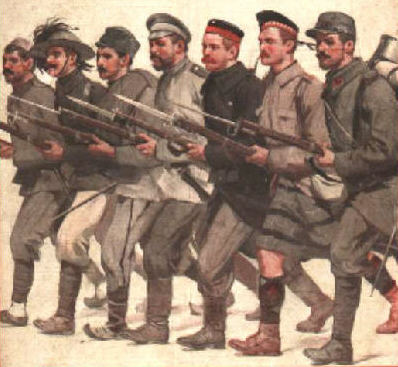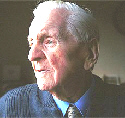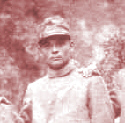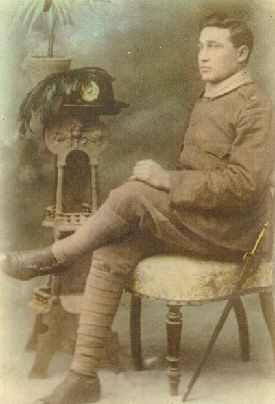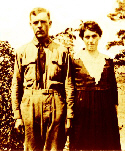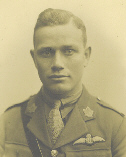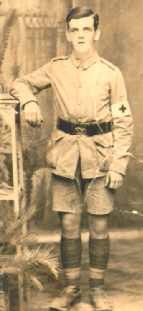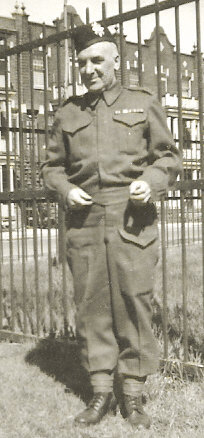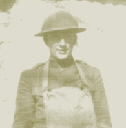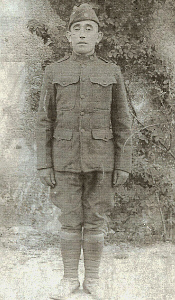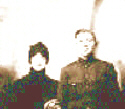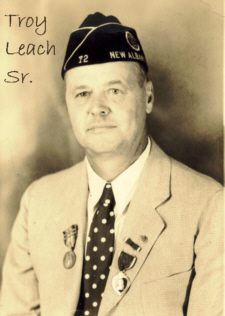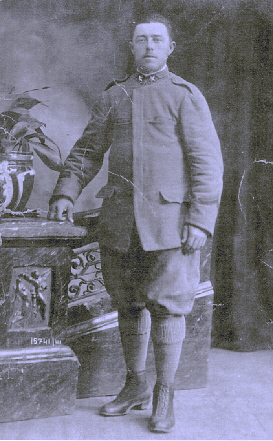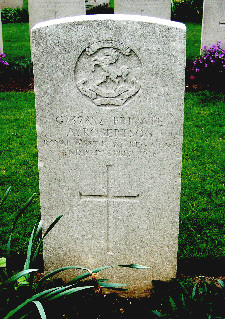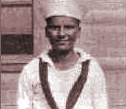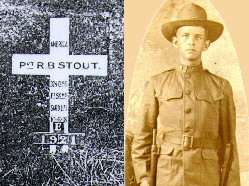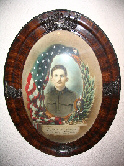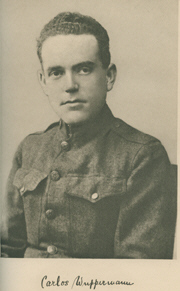|
 Alfred Anderson, 5th Battalion, Black Watch, British Expeditionary Force
Alfred Anderson, 5th Battalion, Black Watch, British Expeditionary Force
On November 22, 2005 there was sad news from the London papers today. Sgt Alfred Anderson, the last survivor of the 1914 Xmas Truce, died in his sleep early Monday morning, November 21st 2005 at the age of 109. Sgt. Anderson served on the Western Front with the 5th Battalion, Black Watch. He had joined the Territorials, with many of his school friends, in 1912. During his young career he served 2 years as Batman to Capt. Fergus Bowes-Lyon, brother to the former Queen Mother, Elizabeth 1st. Capt. Bowes-Lyon was killed at the battle of Loos in 1915. Prince Charles honored Sgt. Anderson by a visit to his home in 2003 to thank him for his service to the Captain.
Sgt. Anderson was wounded at the front in 1916 and was awarded France's highest honor, the Legion d' Honneur, for his service to the French nation during the Great War. Anderson died in a nursing home in the small village of Newtyle, near Dundee, Scotland. He was that country's last veteran of WWI. It was a timely mention when the GWS honored him, along with others, at their Tri-Chapter meeting in Sonoma, California on November 12th last. May he rest in peace.
This leaves 8 known remaining veterans of the Great War in the United Kingdom as of this date.
Source:
Nominated by GWS members Joaquin and Audrey Espinosa
 Carson Angel, US Army
Carson Angel, US Army
My grandfather Carson Angel, known to his grandchildren as "Quack, Quack", was inducted into the US Army in Louisiana [or] Missouri during WWI. His name had been Carson Angle, but, according to family legend, his commanding officer told him his name was too Germanic and thus he reversed the l & e. His issue has had to tolerate the name "Angel" ever since. I don't think he amounted to much but his family tree included Daniel Boone and Kit Carson who had both retired to Missouri and their grandchildren married.
So here's a toast to Quack Quack.
Source:
Nominated by GWS Friend Laurie Angel McGuinness, Granddaughter of Quack, Quack.
 Frank Arnald, Forestry Corps, Canadian Expeditionary Force
Frank Arnald, Forestry Corps, Canadian Expeditionary Force
Frank Arnald was born in Canada and lied about his age to enlist in the CEF. He was spotted in France by doctor from his hometown. He was deemed to be too young to serve in the trenches and was reassigned to the Forestry Corps. He spent his time in France at a mill near the Swiss Border manufacturing duckboards. After the war, he moved to the US and became an electrician. During WWII he served as a US Nave Sea Bee throughout the Pacific. On September 13, 1991 as part of a Great War Society tour group visiting France, Frank Arnald was given the honor or relighting the Eternal Flame for France's Unknown Soldier at the Arc de Triomphe in Paris. Frank was also the subject of the cover photo for Issue 1, Vol.1 of Relevancee, Quarterly Journal of the Great War Society
Source:
Frank Arnald was one of three members of the Great War Society who actually served in World War I.
 Fred Astarita, US Army
Fred Astarita, US Army
When I was very young, he loved to show me photo albums of him in uniform. I had the feeling that his years of military service were definitely among the most memorable of his life.
Source:
Nominated by GWS Friend Yolanda Astarita Patterson
 Adolf Belling, German Army Buried at Menen, Flanders
Adolf Belling, German Army Buried at Menen, Flanders
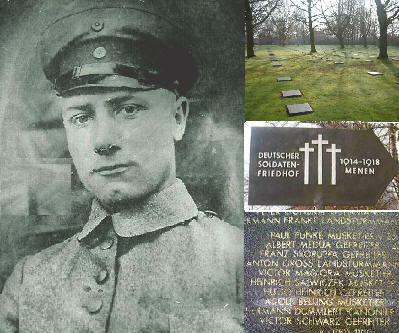
Adolf Belling was born at Landkirchen on the Island of Fehrman, Holstein, Germany. The family did not record the date of his birth. His parents were Gustav and Maria (Wolfe) Belling. Gustav, Maria and three of their children (Agnes, Dora and Emil) immigrated to the United States in 1913. Adolf could not go because he was in the Army. He planned to join them after the war, but he died of Spanish flu on January 6, 1918. He is buried in the German Military Cemetery in Menin, Belgium.
I think, very sad. I choose this Adolf, from many others, because of the link to both sides of the war: The Central powers and the allies.
The cemetery at Menen and Adolf's Marker is shown above.
Source:
Patrick Lernout, Battlefield Researcher from Belgium
 Virgilio Benedetti, Alessandra Brigade, Italian Army
Virgilio Benedetti, Alessandra Brigade, Italian Army
Virgilio Benedetti was an Arditi, a specially trained assault specialist who was deployed in an advance position on the Isonzo Front in 1917. His position was surrounded and he was captured spending the remainder of the war as a prisoner of war. Afterwards, his opposition to the emerging Fasciti movement was so strong he was forced to flee for his life, returning to America where he had been born.
Source:
Nominated by his son GWS member Leo Benedetti
 Bernard Berliner, MD, German Medical Corps
Bernard Berliner, MD, German Medical Corps
When I asked my father how he survived the war and where he served on the front lines of the Western Front, he answered, "I kept my mouth shut." He deplored the war, but never spoke against it. On a long march towards Paris his company stopped to rest. He witnessed an officer berating a soldier for some minor offense (probably his tunic was buttoned properly) and my father said to himself, "If this is how the officers treat their men, we have lost the war."
Source:
Nominated by GWS Friend Gabie Berliner, Daughter of Dr. Berliner
 Ferdinand Bertsch, Provost Marshal, AEF
Ferdinand Bertsch, Provost Marshal, AEF
Mule Skinner with General Pershing in pursuit of Pancho Villa and later sent to France. He spoke German and was placed in charge of German Prisoners of War when he later served in the AEF.
Source:
Nominated by GWS President Sal Compagno
 Joseph Bloom, 38th Royal Fusiliers, British Army
Joseph Bloom, 38th Royal Fusiliers, British Army
My father served in Palestine and Egypt with the British Army. His serial number was 5775. He was in the same tent as David Ben Gurion - who later became Prime Minister of Israel. He had a big trunk shipped from Palestine with his clothes and souvenirs in it. It was lost and he never found it. The Salvation Army lent him a suit when he got married.
Source:
Nominated by his daughter, GWS Member Esther Jennings
 Giacomo Cannella, Bersaglieri Regiment, Italian Army
Giacomo Cannella, Bersaglieri Regiment, Italian Army
Giacomo Cannella was born in Amantea Cosenza, the Region of Calabria, Italy on Sept 5, 1890. He came to the USA when he was a teen with his father Francesco Cannella. He married Adeline Raineri, also from Amantea after she immigrated to the US, and then he chose to go back to serve in the war. He managed to get through the war without being wounded and immigrated once again back to America.
He lived in upstate New York for a while and then settled in Johnsonburg, PA. He was a shoemaker and also worked at the Paper Mill, passing away in 1961.
Source:
Nominated by his granddaughter Steffie Cannella.
 Pvt. Thomas Robert Clayton, US Army, AEF
Pvt. Thomas Robert Clayton, US Army, AEF
Here's the only Picture I have of Private Thomas Robert
Clayton Born March 17, 1887 - March 27,1965 with His
wife Jessie Allie Clayton September 7, 1885 - October 4,
1972. They are buried in the Potts Camp MS. Cemetery.
Looks like Thomas has His WWI Clothes on after war.
Source:
Nominated by Robin Clayton, Walnut MS
 John Lincoln Clem, US Army.
John Lincoln Clem, US Army.

John Clem (1851-1937)Joined the Union Army at age 9 from Ohio as a drummer boy. He gained fame as "Johnny Shiloh," the "Drummer Boy of Chickamauga," and from the song "When Johnny Comes Marching Home." Commissioned directly as a Second Lieutenant, US Army in 1871 his career spanned the Civil War with the modern developments such as trench warfare, troop movement by rail and quick-firing weapons, to the First World War. He retired in 1916 as the last active duty civil war veteran to serve to the Great War. Above is shown the inscription on on his grave marker at Arlington National Cemetery.
Source:
Nominated by GWS Member David Schleeter
 James Curry, PA National Guard, 42nd Rainbow Div., AEF
James Curry, PA National Guard, 42nd Rainbow Div., AEF
Served in France and was mustard gassed. Had recurring problems the rest of his life. Later worked for the Pennsylvania RR at Altoona, PA.
Source:
Nominated by his Great Nephew, GWS Member George Young.
 Jane Delano, Nursing Corps, US Army and Red Cross
Jane Delano, Nursing Corps, US Army and Red Cross
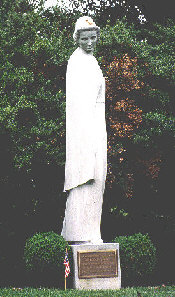
Jane Delano Monument
Washington DC |
Jane Delano was the 2nd head of the Army Nurse Corps and the founder of the Red Cross Nurses. She stressed professionally skilled nurses rather than doctor's assistants. She was responsible for 8,000 nurses at the beginning of the war. By the end, she had overseen the training of 20,000 nurses. She served in the US during the war, but went to France in 1919 where she experienced an infection and died on April 15, 1919. Originally, buried in France, she was later moved to Arlington where she is buried with other nurses who served.
Source:
Nominated by GWS Member and US Army Veteran Anne Steele
 John Giles Farquhar, Infantry/RFC/RAF Canadian Expeditionary Force
John Giles Farquhar, Infantry/RFC/RAF Canadian Expeditionary Force
John Giles Farquhar was a student at the University of Manitoba, in Winnipeg, Canada, in January 1916 when the Canadian Government called for volunteers for the C.E.F. John, and ten other members of his football team all volunteered. Because they were students at the time they were allowed to finish the semester before reporting for duty. Following the end of the school year John began basic training in Canada as part of the Western University Battalion. He departed for England in November 1916 as a member of the 196th Overseas Battalion aboard the S.S. Southland. He arrived in Liverpool on 11-11-16 and was transferred to Seaford for additional training. At some point in the spring of 1917 John decided upon a carrier in aviation. He therefore obtained his discharge from the C.E.F. and was enlisted in the RFC. He trained at various locations throughout England. His final stop was to be the course on aerial gunnery in Scotland. However, upon arrival at that school he was immediately ordered to London for assignment overseas. Arriving in London he was ordered to Salisbury Plain for a quick course in bombing. Following that course he was sent overseas. Upon arrival at the Pilot's Pool he was assigned to No. 25 Squadron, RAF. However, before he could arrive at the squadron he came down with influenza. He was so anxious to join the squadron that he did not wait for a full recovery and subsequently suffered a relapse. Finally fully recovered he reported to No. 25 Squadron in July 1918. He flew with the unit for the duration of the war.
Following the end of the war and his return to Canada John became a professional football player and was the goalie on a traveling team that played throughout Canada and the northern United States. He developed a reputation as one of the best goal tenders in football. Eventually wishing to settle down he quit football and opened up a sporting goods store. Unfortunately the business failed at the time of the Depression. He next accepted an offer to become the General Manage of a professional hockey team in Chicago. When this team could not compete against the Chicago Black Hawks it folded. But John landed on his feet when he accepted the position of Athletic Director for Winter Sports at the University of Wisconsin. John eventually retired in this capacity.
Source:
Nominated by Noel Shirley
 William James Farquhar, BEF Egypt, Medical Corps
William James Farquhar, BEF Egypt, Medical Corps
William James Farquhar was raised in an orphange in Scotland. He served in Egypt with the BEF as a medical assistant, 1914-1917. He recalled one morning while putting his riding breeches on he discovered a six-inch black scorpion in them. On the ward, the sick would be cleared of the sick and injured and then disinfected with ammonia due to cholera and yellow fever. He would get ill from the smell.
After the war he went to trade school and became an engraver. Once he married he worked as a janitor in Aberdeen, Scotland until he retired. In 1960 he immigrated to Paradise, CA where he resided until his death.
Source:
Nominated by US Army Medic Bob Ingram, son-in-law of GWS Member Bill O'Malley.
 James Ferguson, 42nd Battalion Royal Highlanders of Canada, C.E.F.
James Ferguson, 42nd Battalion Royal Highlanders of Canada, C.E.F.
Born in 1890 in Glasgow, Scotland, James Ferguson immigrated to Canada and settled in Montreal, Quebec. On March 15, 1915 he enlisted as a private in the Black Watch 42nd Battalion of the Royal Highlanders of Canada and was sent to the front in France in June of the same year. During the course of the war, he rose to the rank of W.O. Class II, was wounded twice, and was awarded a medal for bravery. He was discharged by reason of demobilization in March of 1919 and upon returning to Canada, joined the Reserves. This photo, taken around 1941, shows him in Reservist uniform.
I never knew my grandfather but I am proud to submit his name for inclusion in the Great War Society's Roll of Honor.
Source:
Submitted by Laurie Clarkson, grand-daughter of James Ferguson
 Steve Guasco, US Army, AEF
Steve Guasco, US Army, AEF
As a very young man Steve Guasco immigrated to the U.S. from Italy. When the U.S. declared war, Steve volunteered; and through this obtained his U.S. citizenship. I know nothing about his military experiences because I first met him as a six-year old in Marin County during WWII. Steve, at that time was a fruit and vegetable peddler who would arise at about 3:00am, drive his 1926 Dodge Truck to the Farmer's market in San Francisco. There he would load up his truck and drive to Marin Country and sell his fruits and vegetables to the housewives. Steve was extremely patriotic, to the point that he would tell his Italian customers, who would speak to him in Italian in an attempt to curry favor with him in obtaining hard to get fruits such as bananas, that they lived in America and should speak English.
Source:
Nominated by Noel Shirley
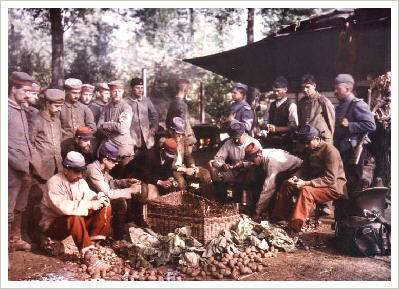
 Albert Haas, Intelligence Section, 309th Infantry, 78th Division, American Expeditionary Force
Albert Haas, Intelligence Section, 309th Infantry, 78th Division, American Expeditionary Force
Albert Haas kept a detailed diary including maps covering his one year's service in France. It was discovered by his daughter, GWS Margaret Haas after his death. In 2003 Margaret visited all the sites her father served in France including Flanders, St. Mihiel, the Argonne where he was wounded and the village of Genay where he recuperated. She is preparing the diary with her commentary added for publication.
Source:
Albert Haas was the father of GWS Member Margaret Haas.
 Brothers William Rees, Robert and Evan Harris, British Army
Brothers William Rees, Robert and Evan Harris, British Army
Uncles Robert and Evan joined the army causing William to lie about his age to join them. They were all born and raised in Llechwen Hall, Ynysybwl, South Wales. Robert and Evan were both lost in France, one is buried in Flanders and the other is listed among the missing on the Menin Gate. William joined the cavalry, also serving in France, but survived having a daughter and a grandson. I only discovered a few years ago that he had been gassed and apparently hospitalized. He died when he was 57 -- the gas was contributory.
Source:
Nominated by the brothers' niece Sylvia Deward and her husband Bob.
 Harry Hoyman, 8th US Infantry, Supply Company. He served in Siberia from September 2, 1918 to September 11, 1919.
Harry Hoyman, 8th US Infantry, Supply Company. He served in Siberia from September 2, 1918 to September 11, 1919.
Harry Hoyman was interested in history all of his life. He was a charter member of the Stephenson County (Illinois) Historical Society and served on its board. He not only wrote an account of his experiences in Siberia, which was published in the book "History of Stephenson County, Illinois" (and which I've transcribed for the Doughboy Center), but he had the foresight to take his camera and enough film to Siberia to take about 80 black and white photos there. I have put some of them on the Doughboy Center to illustrate his article.
It's unfortunate that so little attention was paid within Harry's lifetime to the Siberian Campaign. I was a history major in college in the 1960s, but I knew nothing about it except what I heard from Harry later. Even his friends weren't much interested; it wasn't a battle any of them had heard of, and its results weren't integral to the war. Even when Khrushchev referred to it during his visit to the US in the 1950s, no subsequent articles of explanation were written about it in major US publications. The American people were just allowed to think that Khrushchev was wrong or lying (just like we were encouraged to think all Communists were wrong or lying about everything anyway). It was a real disservice to the veterans of the Siberian Campaign
Source:
Nominated by Alice Horner: Not family, but my parents knew him and his wife for 60+ years. I knew him only vaguely, late in his life.
 Phil Jaffe, American Expeditionary Force
Phil Jaffe, American Expeditionary Force
Phillip Jaffe was born in 1892 in Lithuania and was living in the Lower Eastside of New York City when America entered the war and he joined up. "Papa" Phil returned home after the war and eventually made his way to Miami, where he passed away in 1978.
Source:
Nominated by his grandson Bill Jaffe and GWS friends Anne Merritt and Dana Lombardy.
 Wallace and Oleda Joure, AEF
Wallace and Oleda Joure, AEF
Perhaps the only brother and sister to have been sworn into the U. S. Army together World War I, Wallace and Oleda Joure were three years apart in age. The elder, Wallace, was the bass singer in the First Army Quartet and toured France entertaining the troops. Oleda was one of 223 women to be sworn into the U. S. Army Signal Corps and served as a switchboard operator at General Pershing's Allied Armies HQ in Chaumont. She played piano for the troops when her ship was quarantined with the 1918 flu off Southampton for two weeks, before finishing the journey to France. The image shows Oleda and Wallace on leave in France at Christmas time 1918. Oleda's story has been honored on the Great War Society web site for about a decade now: www.worldwar1.com/dbc/hello.htm
Source:
Nominated by Oleda's daughter, Michelle Christides
 Troy Leach Sr. & Troy Leach Jr., US Army WWI & WWII
Troy Leach Sr. & Troy Leach Jr., US Army WWI & WWII
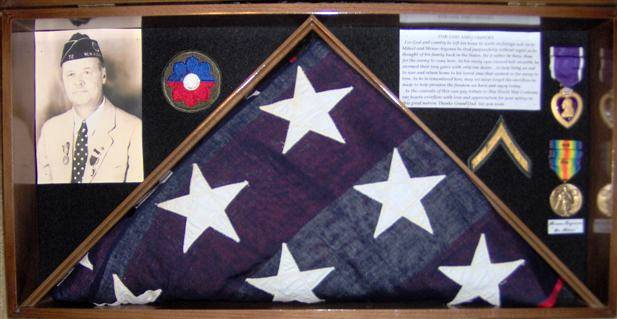
I don't know if these men classify as Heroes but they are to me. My Grandfather Troy Elbert Leach who was wounded October 8 1918 in France By Shrapnel when a Plane bombed an ammo dump while He was stopped helping an officer. He lost part of a Lung and The circulation in His Legs. They stayed cold as Ice. The photo below was taken at a French Hospital Afterwards. I was told He came home on a Hospital Ship. He was born 1895, died 1950.
FOR GOD AND COUNTRY
For God and country he left his home to walk on foreign soil. In St.
Mihiel and Meuse-Argonne he trod purposefully without regret as he thought of his
family back in the States. He’d rather be there, than for the enemy to
come here.
As his steely eyes viewed hell on earth, he stormed their very gates with only one desire…to help bring an end to war and return home to his loved ones that seemed so far away to him. As he is remembered here, may we never forget the sacrifices he made to help preserve the freedom we have and enjoy today.
As the contents of this case pay tribute to this World War I veteran; our hearts overflow with love and appreciation for your service to this great nation.
Thanks Grand Dad. See you soon.
Troy Elbert's son Troy Jr., born 1920 & died 2005, was in North Africa as a Motorcycle Courier. Both lived at Blue Springs Mississippi, all their lives, both Men Proud Americans Who fought Hard Abroad and Here For The U.S.A.
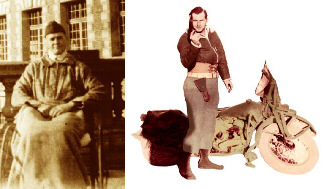
Troy Senior and Troy Junior
Source:
Nominated by Troy Sr's Grandson Bob, and Troy Jr's nephew, Robin Clayton, Walnut MS
 Alexander MacGregor, Royal Artillery, British Army
Alexander MacGregor, Royal Artillery, British Army
Capt. MacGregor served in France and survived the war.
Source:
Maternal Grandfather of GWS Member Frank Jordan
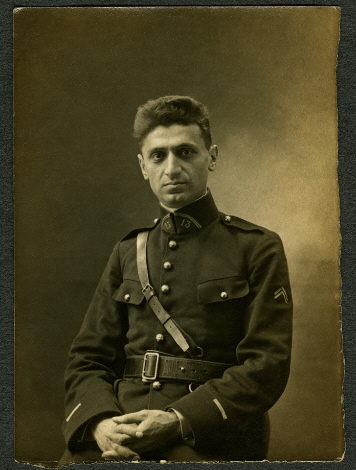
 Nicholas Philip Makanna, American Field Service and French Artillery Corps
Nicholas Philip Makanna, American Field Service and French Artillery Corps
Nicholas Makanna of Bangor, Maine and the University of Maine volunteered for the American Field Service orginally. While in France he transferred to the French Artillery as a 2nd Lt. and is wearing that uniform in the photo above. After the war he returned home and worked 52 years for the Wall Street Journal. His son is aviation historian Phillip Makanna, author of the Ghosts series.
Source:
Son Phil Makanna
 Patrick Malley, 78th Division AEF
Patrick Malley, 78th Division AEF
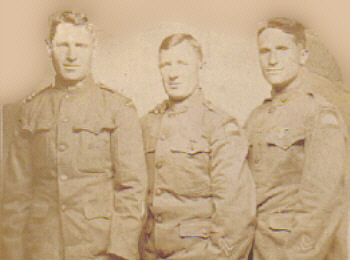
Patrick Malley [L.] of the 78th Lightning Division with two buddies.
Source:
Grandson Dennis McDermott
 John J. Mara, 101st Infantry, 26th Div., AEF
John J. Mara, 101st Infantry, 26th Div., AEF
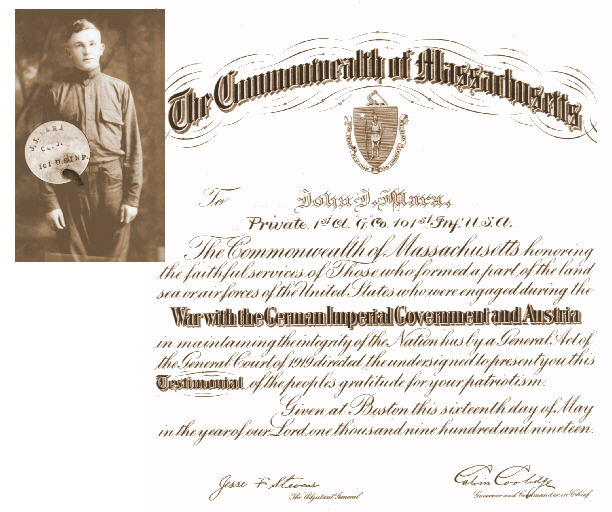
Note that John's Testamonial from the Commonwealth of Massachusetts is signed by governor and future president Calvin Coolidge.
Source:
Nominated by GWS Member Bill O'Malley. John Mara was his brother's father-in-law.
 Harry George Melen, British Army
Harry George Melen, British Army
My grandfather, Harry George Melen, joined the army as a baker. He had a bad experience with an officer who wanted him to fill the field oven completely with dough and it had to be burned out to be used again. My grandfather was disgusted and transferred to the motorcycle dispatch corps. He continued to ride motorcycles for the rest of his life. He did not suffer foolish young officers, gladly. Harry was born in Birmingham, England and lived most of his life in Caefphiluy, South Wales.
Source:
Nominated by Harry's granddaughter Sylvia Deward and her husband Bob.
 Bruno Nadulny, Heavy Cavalry, German Army
Bruno Nadulny, Heavy Cavalry, German Army
My uncle was selected to me a member of the Kaiser's Palace Guard at Potsdam. Guards were selected on the basis of physical attributes (over 6-foot and physically impressive) and sound character. The uniforms they wore were resplendent. With the outbreak of war, he was transferred to the heavy cavalry and saw action. He survived the war and took over the family business, surviving until the 1930s.
Source:
Nominated by his nephew San Francisco Chapter Member Joseph Klammer
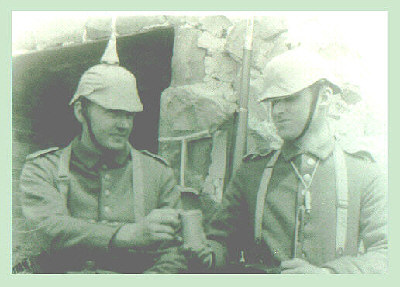
 Ettore Paganoni, Alpini Regiment, Italian Army
Ettore Paganoni, Alpini Regiment, Italian Army
Ettore Paganoni was born 31 December 1899 although military discharge papers state his birth year as 1898. It is probable that he lied about his age as so many others did. He started service as a Carbinieri but later was recruited to the Alpini. He was promoted up to Captain and served in Compagnia di Sussistenza Plotone Staccato Armata di Trieste. He saw most action in Trentino in 1917-18. Supposedly, he was awarded 2-3 medals/campaign ribbon--one British--which he never collected. He was captain of a group of 12 Alpini Snipers assigned to work with the British "foot sloggers" when they deployed to the Italian Front.
After the war he emigrated to Australia and worked sugar cane farms in north Queensland. He was one of the only Italian men of the neighbouring district not to be interned in WW2. Presumably because of fighting with the British in WW1.
Source:
Nominated by his granddaughter Phillippa Paganoni of Australia.

Private Allan Robertson, 47th Division, British Army
Allan Robertson served with several regiments including the Middlesex Regiment (G/96484), the Royal West Kents (G/32882), and last, the 1/20th London Regiment (Blackheath and Woolwich) (G/328820) which was part of 141st (5th London) Brigade of 47th (2nd London) Division. He died of wounds on 2 September 1918, in the Battle of Bapaume and is buried Peronne Road Cemetery, Maricourt, France.
Source:
Nominated by his great niece, Aline McReady of Dundee, Scotland.
 Philip Ernst Rudolph, UC Berkeley Mobile Hospital, AEF
Philip Ernst Rudolph, UC Berkeley Mobile Hospital, AEF
Phillip Ernst Rudolph was part of a group of medical technicians who served in a mobile hospital formed by the University of California which served with the AEF in France. He had been a bacteriologist before WWI.
Source:
Nominated by his grandson, GWS Director Robert Rudolph
 The Reverend Ernest Warburton Shurtleff, DD & Helen Cramer Shurtleff (Mrs. E. W. Shurtleff)
The Reverend Ernest Warburton Shurtleff, DD & Helen Cramer Shurtleff (Mrs. E. W. Shurtleff)
Founders of the Shurtleff Memorial Committee providing relief services to refugees from German occupied French provinces. I have just completed an article on the Shurtleff Committee which will appear in Stand To!, the journal of the Western Front Association in the UK in the spring of 2007. Reverend Shurtleff was a Congregationalist minister from Boston. His wife was from Texas. The Shurtleff's worked to provide spiritual and moral support to expatriate American students on the left bank of Paris beginning in 1906. Reverend Shurtleff died in France on 1917 of overwork and heart failure.
Source:
Nominated by Len Shurtleff of the WFA and GWS
 Edwin Sievers, USN, Marine Brigade, 2nd Division, American Expeditionary Force
Edwin Sievers, USN, Marine Brigade, 2nd Division, American Expeditionary Force
Edwin Sievers lied about his age to enlist in the US Navy during World War I. He became a Corpsman and was assigned to the Marine forces attacking Belleau Wood. He was gassed during the battle and his war was over. He came back in WWII to serve as an intelligence officer in the Army Air Force.
Source:
Edwin Sievers was one of three members of the Great War Society who actually served in World War I.
 Private Carl B. Skidmore, 74th Co, 6th Rgt, 4th Marine Brigade, 2nd Division, AEF.
Private Carl B. Skidmore, 74th Co, 6th Rgt, 4th Marine Brigade, 2nd Division, AEF.
My uncle died of wounds on Nov 1st or 2nd 1918 that he received on Nov 1, 1918 in the Battle of the Argonne. I am preparing the series of letters he wrote from France prior to his death for publication.
Source:
Nominated by Nephew Frank Skidmore, Jr.
 Ralph Smith, 1st & 4th Divisions, American Expeditionary Force
Ralph Smith, 1st & 4th Divisions, American Expeditionary Force
Ralph Smith left his job as a school teacher in Colorado to join the National Guard for service on the Mexican Border. He took and passed the Officer's examination for the regular Army and was included in the first draft of officer's set to France. He was a witness to the trench raid that resulted in the first battlefield casualties of the AEF. While in France he gained considerable expertise in training and studied French at the Sorbornne after the Armistice. This led to his appointment to the faculty of West Point under Douglas MacArthur and later to the Infantry School at Fort Benning under George Marshall. He commanded the 27th Division in WWII, capturing the island of Maken, but was subsequently relieved after a controversy with the Marine commander of the Saipan invasion. He was later in military government in just-liberated Paris and was the first president of CARE.
Source:
Ralph Smith was one of three members of the Great War Society who actually served in World War I.
 Roland Bixby Stout, US Army
Roland Bixby Stout, US Army
This concerns my uncle Roland, who was killed October 6, 1918
in Machir Bay off the North coast of Islay, Scotland while on board the HMS Otranto. I have three letters written by Roland written in August and September, 1918. My Mother was Roland's sister, Gladys
Stout.
One letter to his family reveals that he appreciated packages (smokes and candy) and letters from home, had things at home that he missed (his ball glove) and wanted sent to him. In one letter to Dad he was chiding him about not volunteering when he did as he was having a high old time and was not being treated like draftees (like dogs) which would be in store for Dad when they got him in. ----Can't help
but wonder that me, my brother, and sister, my 3 children, and 4 grandchildren---might not be at all had he been along on that adventure. He mentioned his girl left at home (but not by name) and a girl he had met in Cincinnati, Ohio. He mentions going to preaching every chance he gets.
The last letter I have was written on September 18, 1918 to my Dad in which he is congratulating Dad on joining the best church in the world and attributing it to the BEST Sunday School Teacher in the world. (Again not by name.) He expects to be in France by the middle of October. Lights out was 9:30PM but they had a prayer meeting that night at the YMCA. He promised that "you'll be hearing from me
later." He signed off "So long, I'll be seeing you over there."
He never made it to France and my Dad never had to go into service but being the good Baptists that my Mom and Dad were, they always had expectations of seeing Roland again over there, just not in France.
Roland Bixby Stout was b. 6-12-1900 in Elon College, Alamance County, North Carolina d. 10-6-1918 Islay, Scotland buried Kilchoman Military Cemetery Grave No. 167. [Marker shown here.]
He was returned to USA and buried in Greenhill Cemetery, Greensboro, Guilford County, North Carolina in August, 1920.
Source:
Nominated by Niece Thelma Waters
 Lemuel M. Thomas, 138th Infantry, 35th Division, AEF
Lemuel M. Thomas, 138th Infantry, 35th Division, AEF
My great Uncle, Lemuel M. Thomas, was like a grandfather to me. Uncle Lemmie and his wife Aunt Ruth lived down the road 1/4 mile from us and I spent all the time I could with them. Uncle Lemmie was a quiet man who I felt very safe around as a little boy. The first time I remember hearing that he had been in the war( I was about 4 or 5) I asked him If he had been killed. What little I know of his war experience came mostly from my Mother. He walked with a limp from a machine gun and he breathed funny from being gassed twice. Mom said the first time he was gassed it was just a whiff with no consequence, the second time it knocked him down and he said he would have died but somebody dragged him up on a little rise and gave him something to drink. He never saw him again and never knew who he was. Uncle Lemmie hardly ever spoke of the war but he did tell me one time when I had just shot a turtle on his pond with his 22 rifle that "those rifles they gave us in the war were accurate whatever you could see you could hit". He also told me when we were on the subject of eating "we came across an ox cart that was turned over that had rice in it and we et that rice right into the mud, we were hungry!" Mom also told me that a man asked him if he had killed anyone, she said he just looked at him for a moment and said "cheeky aren't you". I have just recently discovered that he was in the 1st Army 35th division 138th infantry 3rd battalion Co K, it seems the 35th Div. may be sort of infamous. I don't know how Uncle Lemmie proved or disproved himself in battle, but he was and will remain a great man in my eyes. Anyone who comes to know me won't wait very long before they will hear about him and his wife and how much they meant to me.
Source:
Nominated by Great Nephew, Kim Cable
 Virgilio "Vangi" Toci, 46th Division, Italian Army
Virgilio "Vangi" Toci, 46th Division, Italian Army
Served with the Alessandra Brigade.
Source:
Nominated by his Nephew, GWS Member Leo Benedetti
 Frank Wood, Gordan Highlanders, BEF
Frank Wood, Gordan Highlanders, BEF
My Great Uncle was Corporal Frank Wood, of Bucksburn, Aberdeen.
He joined the Gordon Highlanders after seeing Kitchener's poster. He was, however, underage and the Sergeant at the train station was informed of this and said to my Great Great Grandmother, 'Madam, if we were to take every underage boy off of these trains we would not have an army, now step aside'.
They never saw Frank again. He was killed in the Battle of the Somme on Sunday 23rd July 1916. He was 17, and her only son, so the family name died with him.
His name is on the memorial to the missing in Thiepval as when he was found there was only his breast pocket left, which held a photograph of his sister, my Great Grandmother, and this is how they identified him.
My Grandmother found out that her brother was dead after opening the newspaper and seeing her picture with the caption, 'Found on the body of a dead soldier'. They never received a telegram or any of his belongings back, just a very public announcement.
He will always be remembered by our family, even though we did not know him, and I hope to visit the Thiepval Memorial to pay the family respects to Frank as my Grandmother and family never had the opportunity or the resources to do so. It will be 90 years to the day next July. Frank's uncle was also the head of languages at the University in Aberdeen and Frank could actually speak German and write shorthand. I think he would have been more useful to the army with those skills rather than his seniors chucking him over the top as cannon fodder. Sadly we have no pictures of Frank as I would love to know what he looked like. Just a 17 year old hoping he was doing his duty to King and country.
Source:
Nominated by his great niece Veronica Simpson
 Carlos Dámaso Siegert Wuppermann, US Base Hospital #1, Bellevue Unit, Vichy, France and Corps of Intelligence Police, AEF
Carlos Dámaso Siegert Wuppermann, US Base Hospital #1, Bellevue Unit, Vichy, France and Corps of Intelligence Police, AEF
Carlos Wuppermann died at age 31 under mysterious circumstances of a single gunshot wound to the head while in the C.I.P. with the Army of Occupation in Trier, Germany, April 15, 1919 the same day as Red Cross nurse Jane Delano. Was a professional actor, poet, writer and playwright. Graduated from Columbia University and was a member of Phi Gamma Delta fraternity. His youngest brother was Frank Morgan, the "Wizard of Oz," and an elder brother, actor Ralph Morgan, co-founded the Screen Actors Guild in 1933. Carlos is buried under a large white marble cross at The Green-wood Cemetery in Brooklyn NY, with Frank, Ralph and other family members in the Hancox/Wuppermann plot, lot 14447, Section 168.
Source:
Nominated by GWS Member Valerie Yaros
For more Legends and Traditions of the
Great War return to the
Contents Page
|
For Great War Society
Membership Information

Click on Icon |
For further information on the events of 1914-1918
visit the homepage of
The Great War Society
|
Additions and comments on these pages may be directed to:
Michael E. Hanlon
(medwardh@hotmail.com)Original artwork & copy; © 1998-2005, TGWS.
|
|

